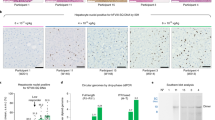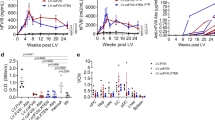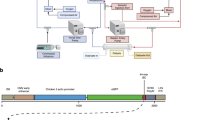Abstract
Although therapeutic outcomes have been achieved in hemophilia patients after delivery of clotting factor genes to the liver using adeno-associated virus (AAV) vectors, it is well known that the preclinical results generated from hemophilia animal models have not been directly predictive of successful translation in humans. To address this discrepancy humanized mouse models have recently been used to predict AAV transduction efficiency for human hepatocytes. In this study we evaluated AAV vector transduction from several serotypes in human liver hepatocytes xenografted into chimeric mice. After systemic administration of AAV vectors encoding a GFP transgene in humanized mice, the liver was harvested for either immunohistochemistry staining or flow cytometry assay for AAV human hepatocyte transduction analysis. We observed that AAV7 consistently transduced human hepatocytes more efficiently than other serotypes in both immunohistochemistry assay and flow cytometry analysis. To better assess the future application of AAV7 for systemic administration in the treatment of hemophilia or other liver diseases, we analyzed the prevalence of neutralizing antibodies (NAbs) to AAV7 in sera from healthy subjects and patients with hemophilia. In the general population, the prevalence of NAbs to AAV7 was lower than that of AAV2 or AAV3B. However, a higher prevalence of AAV7 NAbs was found in patients with hemophilia. In summary, results from this study suggest that AAV7 vectors should be considered as an effective vehicle for human liver targeting in future clinical trials.
This is a preview of subscription content, access via your institution
Access options
Subscribe to this journal
Receive 12 print issues and online access
$259.00 per year
only $21.58 per issue
Buy this article
- Purchase on Springer Link
- Instant access to full article PDF
Prices may be subject to local taxes which are calculated during checkout




Similar content being viewed by others
References
George LA, Sullivan SK, Giermasz A, Rasko JEJ, Samelson-Jones BJ, Ducore J. et al. Hemophilia B gene therapy with a high-specific-activity factor IX variant. N Engl J Med. 2017;377:2215–27. https://doi.org/10.1056/NEJMoa1708538.
Nathwani AC, Reiss UM, Tuddenham EG, Rosales C, Chowdary P, McIntosh J. et al. Long-term safety and efficacy of factor IX gene therapy in hemophilia B. N Engl J Med. 2014;371:1994–2004. https://doi.org/10.1056/NEJMoa1407309.
Nathwani AC, Tuddenham EG, Rangarajan S, Rosales C, McIntosh J, Linch DC. et al. Adenovirus-associated virus vector-mediated gene transfer in hemophilia B. N Engl J Med. 2011;365:2357–65. https://doi.org/10.1056/NEJMoa1407309.
Baruteau J, Waddington SN, Alexander IE, Gissen P. Gene therapy for monogenic liver diseases: clinical successes, current challenges and future prospects. J Inherit Metab Dis. 2017;40:497–517. https://doi.org/10.1007/s10545-017-0053-3.
George LA. Hemophilia gene therapy comes of age. Blood Adv. 2017;1:2591–9. https://doi.org/10.1182/bloodadvances.2017009878.
Hocquemiller M, Giersch L, Audrain M, Parker S, Cartier N. Adeno-associated virus-based gene therapy for CNS diseases. Hum Gene Ther. 2016;27:478–96. https://doi.org/10.1089/hum.2016.087.
Gao G, Vandenberghe LH, Wilson JM. New recombinant serotypes of AAV vectors. Curr Gene Ther. 2005;5:285–97.
Balakrishnan B, Jayandharan GR. Basic biology of adeno-associated virus (AAV) vectors used in gene therapy. Curr Gene Ther. 2014;14:86–100.
Zincarelli C, Soltys S, Rengo G, Rabinowitz JE. Analysis of AAV serotypes 1-9 mediated gene expression and tropism in mice after systemic injection. Mol Ther. 2008;16:1073–80. https://doi.org/10.1038/mt.2008.76.
Srivastava A. In vivo tissue-tropism of adeno-associated viral vectors. Curr Opin Virol. 2016;21:75–80. https://doi.org/10.1016/j.coviro.2016.08.003.
Nathwani AC, Gray JT, Ng CY, Zhou J, Spence Y, Waddington SN. et al. Self-complementary adeno-associated virus vectors containing a novel liver-specific human factor IX expression cassette enable highly efficient transduction of murine and nonhuman primate liver. Blood. 2006;107:2653–61. https://doi.org/10.1182/blood-2005-10-4035.
Nathwani AC, Rosales C, McIntosh J, Rastegarlari G, Nathwani D, Raj D. et al. Long-term safety and efficacy following systemic administration of a self-complementary AAV vector encoding human FIX pseudotyped with serotype 5 and 8 capsid proteins. Mol Ther. 2011;19:876–85. https://doi.org/10.1038/mt.2010.274.
Nathwani AC, Gray JT, McIntosh J, Ng CY, Zhou J, Spence Y. et al. Safe and efficient transduction of the liver after peripheral vein infusion of self-complementary AAV vector results in stable therapeutic expression of human FIX in nonhuman primates. Blood. 2007;109:1414–21. https://doi.org/10.1182/blood-2006-03-010181.
Wang L, Calcedo R, Nichols TC, Bellinger DA, Dillow A, Verma IM. et al. Sustained correction of disease in naive and AAV2-pretreated hemophilia B dogs: AAV2/8-mediated, liver-directed gene therapy. Blood. 2005;105:3079–86. https://doi.org/10.1182/blood-2004-10-3867.
Jiang H, Couto LB, Patarroyo-White S, Liu T, Nagy D, Vargas JA. et al. Effects of transient immunosuppression on adenoassociated, virus-mediated, liver-directed gene transfer in rhesus macaques and implications for human gene therapy. Blood. 2006;108:3321–8. https://doi.org/10.1182/blood-2006-04-017913.
Manno CS, Pierce GF, Arruda VR, Glader B, Ragni M, Rasko JJ. et al. Successful transduction of liver in hemophilia by AAV-Factor IX and limitations imposed by the host immune response. Nat Med. 2006;12:342–7. https://doi.org/10.1038/nm1358.
Nietupski JB, Hurlbut GD, Ziegler RJ, Chu Q, Hodges BL, Ashe KM. et al. Systemic administration of AAV8-alpha-galactosidase A induces humoral tolerance in nonhuman primates despite low hepatic expression. Mol Ther. 2011;19:1999–2011. https://doi.org/10.1038/mt.2011.119.
Davidoff AM, Gray JT, Ng CY, Zhang Y, Zhou J, Spence Y. et al. Comparison of the ability of adeno-associated viral vectors pseudotyped with serotype 2, 5, and 8 capsid proteins to mediate efficient transduction of the liver in murine and nonhuman primate models. Mol Ther. 2005;11:875–88. https://doi.org/10.1016/j.ymthe.2004.12.022.
Markusic DM, Nichols TC, Merricks EP, Palaschak B, Zolotukhin I, Marsic D. et al. Evaluation of engineered AAV capsids for hepatic factor IX gene transfer in murine and canine models. J Transl Med. 2017;15:94. https://doi.org/10.1186/s12967-017-1200-1.
Bissig-Choisat B, Wang L, Legras X, Saha PK, Chen L, Bell P. et al. Development and rescue of human familial hypercholesterolaemia in a xenograft mouse model. Nat Commun. 2015;6:7339 https://doi.org/10.1038/ncomms8339.
Azuma H, Paulk N, Ranade A, Dorrell C, Al-Dhalimy M, Ellis E. et al. Robust expansion of human hepatocytes in Fah−/−/Rag2−/−/Il2rg−/− mice. Nat Biotechnol. 2007;25:903–10. https://doi.org/10.1038/nbt1326.
Boutin S, Monteilhet V, Veron P, Leborgne C, Benveniste O, Montus MF. et al. Prevalence of serum IgG and neutralizing factors against adeno-associated virus (AAV) types 1, 2, 5, 6, 8, and 9 in the healthy population: implications for gene therapy using AAV vectors. Hum Gene Ther. 2010;21:704–12. https://doi.org/10.1089/hum.2009.182.
Calcedo R, Morizono H, Wang L, McCarter R, He J, Jones D. et al. Adeno-associated virus antibody profiles in newborns, children, and adolescents. Clin Vaccine Immunol. 2011;18:1586–8. https://doi.org/10.1128/CVI.05107-11.
Calcedo R, Vandenberghe LH, Gao G, Lin J, Wilson JM. Worldwide epidemiology of neutralizing antibodies to adeno-associated viruses. J Infect Dis. 2009;199:381–90. https://doi.org/10.1086/595830.
Mingozzi F, Chen Y, Edmonson SC, Zhou S, Thurlings RM, Tak PP. et al. Prevalence and pharmacological modulation of humoral immunity to AAV vectors in gene transfer to synovial tissue. Gene Ther. 2013;20:417–24. https://doi.org/10.1038/gt.2012.55.
Halbert CL, Miller AD, McNamara S, Emerson J, Gibson RL, Ramsey B. et al. Prevalence of neutralizing antibodies against adeno-associated virus (AAV) types 2, 5, and 6 in cystic fibrosis and normal populations: implications for gene therapy using AAV vectors. Hum Gene Ther. 2006;17:440–7. https://doi.org/10.1089/hum.2006.17.440.
Arruda VR, Stedman HH, Haurigot V, Buchlis G, Baila S, Favaro P. et al. Peripheral transvenular delivery of adeno-associated viral vectors to skeletal muscle as a novel therapy for hemophilia B. Blood. 2010;115:4678–88. https://doi.org/10.1182/blood-2009-12-261156.
Haurigot V, Mingozzi F, Buchlis G, Hui DJ, Chen Y, Basner-Tschakarjan E. et al. Safety of AAV factor IX peripheral transvenular gene delivery to muscle in hemophilia B dogs. Mol Ther. 2010;18:1318–29. https://doi.org/10.1038/mt.2010.73.
Scallan CD, Jiang H, Liu T, Patarroyo-White S, Sommer JM, Zhou S. et al. Human immunoglobulin inhibits liver transduction by AAV vectors at low AAV2 neutralizing titers in SCID mice. Blood. 2006;107:1810–7. https://doi.org/10.1182/blood-2005-08-3229.
Xiao X, Li J, Samulski RJ. Production of high-titer recombinant adeno-associated virus vectors in the absence of helper adenovirus. J Virol. 1998;72:2224–32.
Lisowski L, Dane AP, Chu K, Zhang Y, Cunningham SC, Wilson EM. et al. Selection and evaluation of clinically relevant AAV variants in a xenograft liver model. Nature. 2014;506:382–6. https://doi.org/10.1038/nature12875.
Wang L, Bell P, Somanathan S, Wang Q, He Z, Yu H. et al. Comparative study of liver gene transfer with AAV vectors based on natural and engineered AAV capsids. Mol Ther. 2015;23:1877–87. https://doi.org/10.1038/mt.2015.179.
Li S, Ling C, Zhong L, Li M, Su Q, He R. et al. Efficient and targeted transduction of nonhuman primate liver with systemically delivered optimized AAV3B vectors. Mol Ther. 2015;23:1867–76. https://doi.org/10.1038/mt.2015.174.
Vercauteren K, Hoffman BE, Zolotukhin I, Keeler GD, Xiao JW, Basner-Tschakarjan E. et al. Superior in vivo transduction of human hepatocytes using engineered AAV3 capsid. Mol Ther. 2016;24:1042–9. https://doi.org/10.1038/mt.2016.61.
Gao GP, Alvira MR, Wang L, Calcedo R, Johnston J, Wilson JM. Novel adeno-associated viruses from rhesus monkeys as vectors for human gene therapy. Proc Natl Acad Sci USA. 2002;99:11854–9. https://doi.org/10.1073/pnas.182412299.
Daya S, Berns KI. Gene therapy using adeno-associated virus vectors. Clin Microbiol Rev. 2008;21:583–93. https://doi.org/10.1128/CMR.00008-08.
Gao GP, Lu Y, Sun X, Johnston J, Calcedo R, Grant R, et al. High-level transgene expression in nonhuman primate liver with novel adeno-associated virus serotypes containing self-complementary genomes. J Virol. 2006;80:6192–4. https://doi.org/10.1128/JVI.00526-06.
Gao G, Lu Y, Calcedo R, Grant RL, Bell P, Wang L. et al. Biology of AAV serotype vectors in liver-directed gene transfer to nonhuman primates. Mol Ther. 2006;13:77–87. https://doi.org/10.1016/j.ymthe.2005.08.017.
Wang L, Louboutin JP, Bell P, Greig JA, Li Y, Wu D, et al. Muscle-directed gene therapy for hemophilia B with more efficient and less immunogenic AAV vectors. J Thromb Haemost. 2011;9:2009–19. https://doi.org/10.1111/j.1538-7836.2011.04491.x.
Bish LT, Morine K, Sleeper MM, Sanmiguel J, Wu D, Gao G. et al. Adeno-associated virus (AAV) serotype 9 provides global cardiac gene transfer superior to AAV1, AAV6, AAV7, and AAV8 in the mouse and rat. Human gene therapy. 2008;19:1359–68. https://doi.org/10.1089/hum.2008.123.
Lebherz C, Maguire A, Tang W, Bennett J, Wilson JM, Novel AAV. serotypes for improved ocular gene transfer. J Gene Med. 2008;10:375–82. https://doi.org/10.1002/jgm.1126.
Strobel B, Miller FD, Rist W, Lamla T. Comparative analysis of cesium chloride- and iodixanol-based purification of recombinant adeno-associated viral vectors for preclinical applications. Human Gene Therapy Methods. 2015;26:147–57. https://doi.org/10.1089/hgtb.2015.051
Gao K, Li M, Zhong L, Su Q, Li J, Li S, et al. Empty virions in AAV8 vector preparations reduce transduction efficiency and may cause total viral particle dose-limiting side-effects. Mol Ther Methods Clin Dev. 2014;1:20139. https://doi.org/10.1038/mtm.2013.9.
Erles K, Sebökovà P, Schlehofer JR. Update on the prevalence of serum antibodies (IgG and IgM) to adeno-associated virus (AAV). J Med Virol. 1999;59:406–11.
Li C, Narkbunnam N, Samulski RJ, Asokan A, Hu G, Jacobson LJ. et al. Neutralizing antibodies against adeno-associated virus examined prospectively in pediatric patients with hemophilia. Gene Ther. 2012;19:288–94. https://doi.org/10.1038/gt.2011.90.
Murphy SL, Li H, Mingozzi F, Sabatino DE, Hui DJ, Edmonson SA, et al. Diverse IgG subclass responses to adeno-associated virus infection and vector administration. J Med Virol. 2009;81:65–74. https://doi.org/10.1002/jmv.21360.
Acknowledgements
We thank UNC Vector Core for AAV vector production. The authors acknowledge the UNC Histological Research Core and Flow Cytometry Core Facilities for their assistance in liver immunohistochemistry and flow cytometry analysis. This work was supported by National Institutes of Health Grants R01HL125749 and R01HL144661 (to TCN and CL), and R01AI117408 and P01HL112761 (to RJS and CL).
Author information
Authors and Affiliations
Corresponding author
Ethics declarations
Conflict of interest
RJS is the founder and a shareholder at Asklepios BioPharmaceutical and Bamboo Therapeutics, Inc. He holds patents that have been licensed by UNC to Asklepios Biopharmaceutical, for which he receives royalties. He has consulted for Baxter Healthcare and has received payment for speaking. CL is a cofounder of Bedrock Therapeutics, Inc. He has licensed patents by UNC and has received royalties from Bedrock Therapeutics and Asklepios Biopharmaceutical. The other authors declare that they have no conflict of interest.
Additional information
Publisher’s note Springer Nature remains neutral with regard to jurisdictional claims in published maps and institutional affiliations.
Supplementary information
Rights and permissions
About this article
Cite this article
Shao, W., Pei, X., Cui, C. et al. Superior human hepatocyte transduction with adeno-associated virus vector serotype 7. Gene Ther 26, 504–514 (2019). https://doi.org/10.1038/s41434-019-0104-5
Received:
Revised:
Accepted:
Published:
Issue Date:
DOI: https://doi.org/10.1038/s41434-019-0104-5
This article is cited by
-
Liver targeting with rAAV7: balancing tropism with immune profiles
Gene Therapy (2021)
-
Gene therapy for cardiovascular diseases in China: basic research
Gene Therapy (2020)
-
Engineering adeno-associated virus vectors for gene therapy
Nature Reviews Genetics (2020)



